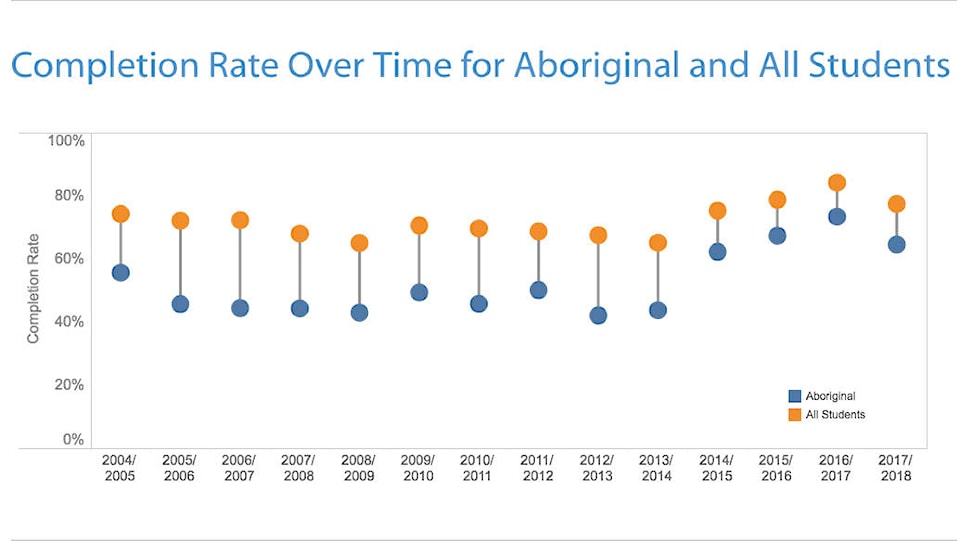After five years of steady increases, Coast Mountains School District 82 saw student graduation rates fall by eight per cent in 2018.
The overall completion rate for CMSD82 (Terrace, Kitimat, Hazelton, Stewart) was 77 per cent for the last school year, down from 84 per cent in 2016/2017. Completion rates for graduating Indigenous students also fell, from 73 per cent to 65 per cent. Sixty-six per cent of students with special needs received a diploma, down from 71 per cent last year.
Provincially, the overall graduation rates hit all-time highs this year, with 86 per cent of all students and 76 per cent of Indigenous students receiving Dogwood or Adult diplomas.
The grad rates, also known as six-year-completion rates, are not actually clear cut percentages of Grade 12 students who earn diplomas. Rates are based on the Grade 8 students who started in this district six years ago. Those students are tracked, and then the number who graduate, whether in this district or elsewhere, tally up to give the school district’s grad rate percentage.
READ MORE: Graduation rates climb significantly in Coast Mountains School District
Fluctuations are typically expected year to year, says school district superintendent Katherine McIntosh. When there is a decline, the district turns to the Ministry of Education for possible explanations for the downturn.
“What we’re learning in the last round was that we had a smaller cohort of graduates than the previous year,” McIntosh says.
According to the ministry, the number of students going through the K-12 system in CMSD82 has declined by 31 per cent over the last 14 years, from 6,235 in 2004-2005 to 4,241 in 2017-2018. Neighbouring School Districts 52 (Prince Rupert) and 54 (Bulkley Valley) also saw similar decreases over the same time period.
McIntosh says the combination of smaller student cohorts and increased enrollment for the Evergreen program, rather than the Adult or Dogwood programs, could also provide an explanation for the decline in graduates.
The Evergreen certificate is a completion certificate issued to some special needs students who may be unable to meet graduation requirements, though it is not recognized as a graduation certification, like a Dogwood or Adult diploma.
READ MORE: Student independence goal of high school grad program
“Although it’s a recognized pathway to graduation, the ministry doesn’t count that in their six-year completion rates,” McIntosh says.
Only B.C. students with special needs and an individualized education plan qualify for the program. Stricter qualifications were implemented in 2016 by the ministry after the province’s auditor general raised concerns that a disproportionately high number of Indigenous students were receiving these certificates.
According to the ministry’s annual Indigenous education report for CMSD82, 17 students out of 192 Indigenous students — nine per cent — completed the 2017-2018 year with an Evergreen certificate. Fewer than nine out of 263 non-Indigenous students received an Evergreen certificate.
Going forward, literacy, numeracy and attendance levels were identified as areas where the district will be focussed, McIntosh says, along with increased outreach and forums to hear feedback from the students themselves.
The district is also working on partnerships with First Nations communities in the region and developing a five-year school district language revitalization plan with the First Peoples’ Cultural Council to increase the offerings of Indigenous languages in schools —starting with an initial focus on the Tsimshian languages.
“We started to do a bit of that work in this past year but as we move forward and increase those offerings for our students, again we’ll see increased engagement… students will see themselves and their culture respected and reflected in their schools,” McIntosh says.
Despite the drop in graduation rates this year, she says the district has come a long way to improve them over the last five years.
In 2013, 65 per cent of the district’s entire student body and only 43 per cent of Indigenous students completed high school with a Dogwood or Adult diplomas — that percentage has jumped by 18 and 50 per cent since.
“We’ve seen such a huge increase in the number of students of Indigenous ancestry graduating, students with special needs graduating, and our graduation rates overall,” McIntosh says.
She says it’s the product of several significant changes which included an asserted effort to know the academic level of every student and establishing a coordinated, district-wide assessment to show how students were performing in reading, writing and math.
Five years ago, the district began working with consultant Lorna Williams to implement First Peoples Principles of Learning in the curriculum, which recognizes learning as sacred and requires the exploration of one’s identity.
They also work with the ministry to develop a database to track every student and their pathway to graduation.
“That’s one of the main reasons why we’ve had such an increased trajectory over five years, is really knowing where every student is at and what their story is,” McIntosh says.
“We need to entrench those practices and ensure that we continue with them, and at the same time, being open to what we’re hearing from our communities our families and our students.”
brittany@terracestandard.com
Like us on Facebook and follow us on Twitter
